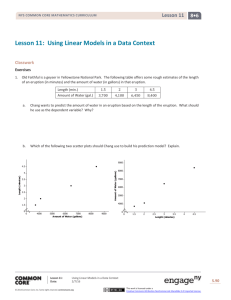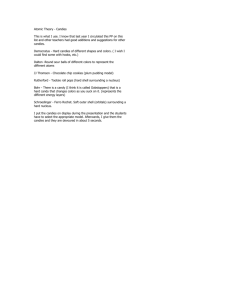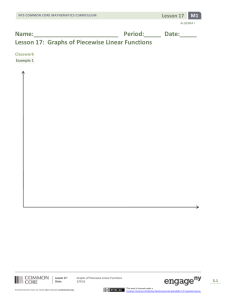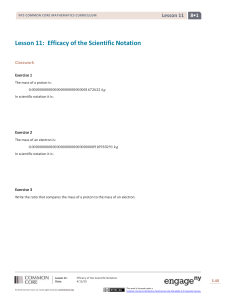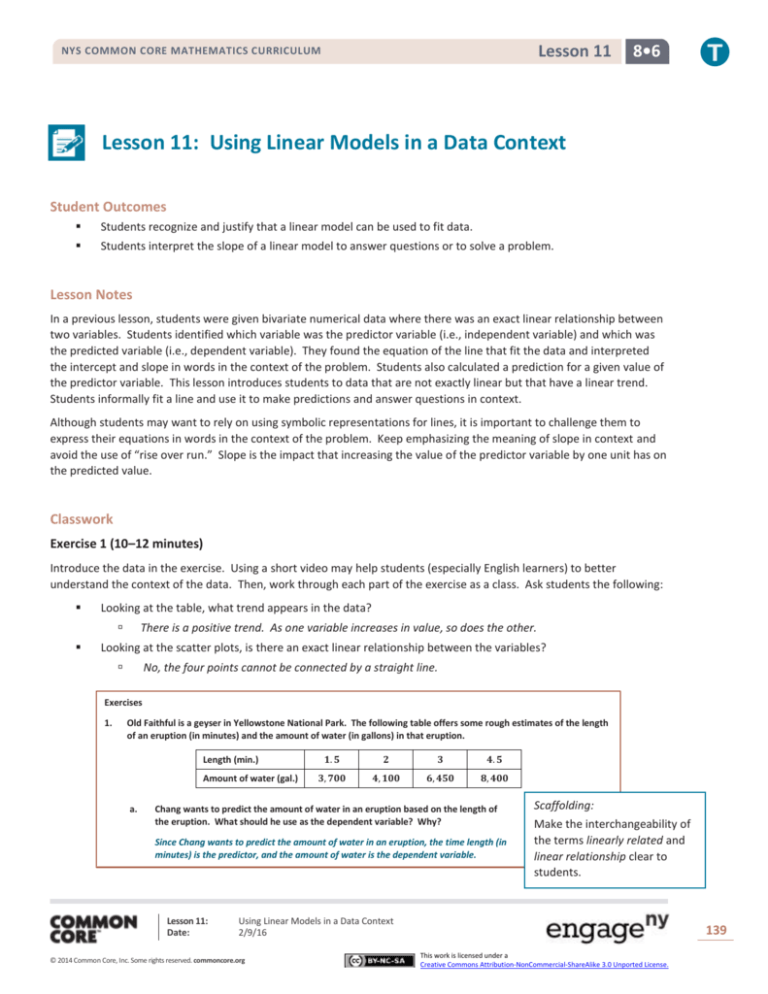
Lesson 11
NYS COMMON CORE MATHEMATICS CURRICULUM
8•6
Lesson 11: Using Linear Models in a Data Context
Student Outcomes
Students recognize and justify that a linear model can be used to fit data.
Students interpret the slope of a linear model to answer questions or to solve a problem.
Lesson Notes
In a previous lesson, students were given bivariate numerical data where there was an exact linear relationship between
two variables. Students identified which variable was the predictor variable (i.e., independent variable) and which was
the predicted variable (i.e., dependent variable). They found the equation of the line that fit the data and interpreted
the intercept and slope in words in the context of the problem. Students also calculated a prediction for a given value of
the predictor variable. This lesson introduces students to data that are not exactly linear but that have a linear trend.
Students informally fit a line and use it to make predictions and answer questions in context.
Although students may want to rely on using symbolic representations for lines, it is important to challenge them to
express their equations in words in the context of the problem. Keep emphasizing the meaning of slope in context and
avoid the use of “rise over run.” Slope is the impact that increasing the value of the predictor variable by one unit has on
the predicted value.
Classwork
Exercise 1 (10–12 minutes)
Introduce the data in the exercise. Using a short video may help students (especially English learners) to better
understand the context of the data. Then, work through each part of the exercise as a class. Ask students the following:
Looking at the table, what trend appears in the data?
There is a positive trend. As one variable increases in value, so does the other.
Looking at the scatter plots, is there an exact linear relationship between the variables?
No, the four points cannot be connected by a straight line.
Exercises
1.
Old Faithful is a geyser in Yellowstone National Park. The following table offers some rough estimates of the length
of an eruption (in minutes) and the amount of water (in gallons) in that eruption.
Length (min.)
Amount of water (gal.)
a.
𝟏. 𝟓
𝟐
𝟑
𝟒. 𝟓
𝟑, 𝟕𝟎𝟎
𝟒, 𝟏𝟎𝟎
𝟔, 𝟒𝟓𝟎
𝟖, 𝟒𝟎𝟎
Chang wants to predict the amount of water in an eruption based on the length of
the eruption. What should he use as the dependent variable? Why?
Since Chang wants to predict the amount of water in an eruption, the time length (in
minutes) is the predictor, and the amount of water is the dependent variable.
Lesson 11:
Date:
Scaffolding:
Make the interchangeability of
the terms linearly related and
linear relationship clear to
students.
Using Linear Models in a Data Context
2/9/16
© 2014 Common Core, Inc. Some rights reserved. commoncore.org
139
This work is licensed under a
Creative Commons Attribution-NonCommercial-ShareAlike 3.0 Unported License.
Lesson 11
NYS COMMON CORE MATHEMATICS CURRICULUM
b.
8•6
Which of the following two scatter plots should Chang use to build his prediction model? Explain.
The predicted variable goes on the vertical axis with the predictor on the horizontal axis. So, the amount of
water goes on the 𝒚-axis. The plot on the graph on the right should be used.
9000
Amount of Water (gallons)
4.5
Length (minutes)
4
3.5
3
2.5
2
7000
6000
5000
4000
1.5
0
8000
0
c.
4000
5000
6000
7000
Amount of Water (gallons)
8000
9000
0
0
1.5
2
2.5
3
3.5
Length (minutes)
4
4.5
Suppose that Chang believes the variables to be linearly related. Use the first and last data points in the table
to create a linear prediction model.
The slope is determined by
𝟖𝟒𝟎𝟎−𝟑𝟕𝟎𝟎
𝟒.𝟓−𝟏.𝟓
= 𝟏, 𝟓𝟔𝟔. 𝟕 gallons per minute.
So, 𝒚 = 𝒂 + (𝟏𝟓𝟔𝟔. 𝟕)𝒙.
Using either (𝟏. 𝟓, 𝟑𝟕𝟎𝟎) or (𝟒. 𝟓, 𝟖𝟒𝟎𝟎) allows you to solve for the intercept. For example, solving 𝟑𝟕𝟎𝟎 =
𝒂 + (𝟏𝟓𝟔𝟔. 𝟕)(𝟏. 𝟓) for 𝒂, yields 𝒂 = 𝟏𝟑𝟒𝟗. 𝟗𝟓, or rounded to 𝟏, 𝟑𝟓𝟎. 𝟎 gallons. Be sure your students talk
through the units in each step of the calculations.
The (informal) linear prediction model is 𝒚 = 𝟏𝟑𝟓𝟎. 𝟎 + 𝟏𝟓𝟔𝟔. 𝟕𝒙. The amount of water (𝒚) is in gallons and
the length of the eruption (𝒙) is in minutes.
d.
A friend of Chang’s told him that Old Faithful produces about 𝟑, 𝟎𝟎𝟎 gallons of water for every minute that it
erupts. Does the linear model from part (c) support what Chang’s friend said? Explain.
This question requires students to interpret slope. An additional minute in eruption length results in a
prediction of an additional 𝟏, 𝟓𝟔𝟔. 𝟕 gallons of water produced. So, Chang’s friend who claims Old Faithful
produces 𝟑, 𝟎𝟎𝟎 gallons of water a minute must be thinking of a different geyser.
e.
Using the linear model from part (c), does it make sense to interpret the 𝒚-intercept in the context of this
problem? Explain.
No, because if the length of an eruption is 𝟎, then it cannot produce 𝟏, 𝟑𝟓𝟎 gallons of water. (Convey to
students that some linear models will have 𝒚-intercepts that do not make sense within the context of a
problem.)
Exercise 2 (15–20 minutes)
Let students work in small groups or with a partner. Introduce the data in the table. Note that the mean times of the
three medal winners are provided for each year. Let students work on the exercise and confirm answers to parts (c)–(f)
as a class. After answers have been confirmed, ask the class:
What is the meaning of the 𝑦-intercept from part (c)?
The 𝑦-intercept from part (c) is (0, 34.91). It does not make sense within the context of the problem.
In year 0, the mean medal time was 34.91 seconds.
Lesson 11:
Date:
Using Linear Models in a Data Context
2/9/16
© 2014 Common Core, Inc. Some rights reserved. commoncore.org
140
This work is licensed under a
Creative Commons Attribution-NonCommercial-ShareAlike 3.0 Unported License.
Lesson 11
NYS COMMON CORE MATHEMATICS CURRICULUM
2.
8•6
The following table gives the times of the gold, silver, and bronze medal winners for the men’s 𝟏𝟎𝟎 meter race (in
seconds) for the past 𝟏𝟎 Olympic Games.
Year
Gold
Silver
Bronze
Mean time
a.
2012
𝟗. 𝟔𝟑
𝟗. 𝟕𝟓
𝟗. 𝟕𝟗
𝟗. 𝟕𝟐
2008
𝟗. 𝟔𝟗
𝟗. 𝟖𝟗
𝟗. 𝟗𝟏
𝟗. 𝟖𝟑
2004
𝟗. 𝟖𝟓
𝟗. 𝟖𝟔
𝟗. 𝟖𝟕
𝟗. 𝟖𝟔
2000
𝟗. 𝟖𝟕
𝟗. 𝟗𝟗
𝟏𝟎. 𝟎𝟒
𝟗. 𝟗𝟕
1996
𝟗. 𝟖𝟒
𝟗. 𝟖𝟗
𝟗. 𝟗𝟎
𝟗. 𝟖𝟖
1992
𝟗. 𝟗𝟔
𝟏𝟎. 𝟎𝟐
𝟏𝟎. 𝟎𝟒
𝟏𝟎. 𝟎𝟏
1988
𝟗. 𝟗𝟐
𝟗. 𝟗𝟕
𝟗. 𝟗𝟗
𝟗. 𝟗𝟔
1984
𝟗. 𝟗𝟗
𝟏𝟎. 𝟏𝟗
𝟏𝟎. 𝟐𝟐
𝟏𝟎. 𝟏𝟑
1980
𝟏𝟎. 𝟐𝟓
𝟏𝟎. 𝟐𝟓
𝟏𝟎. 𝟑𝟗
𝟏𝟎. 𝟑𝟎
1976
𝟏𝟎. 𝟎𝟔
𝟏𝟎. 𝟎𝟕
𝟏𝟎. 𝟏𝟒
𝟏𝟎. 𝟎𝟗
If you wanted to describe how mean times change over the years, which variable would you use as the
independent variable, and which would you use as the dependent variable?
Mean medal time (dependent variable) is being predicted based on year (independent variable).
b.
Draw a scatter plot to determine if the relationship between mean time and year appears to be linear.
Comment on any trend or pattern that you see in the scatter plot.
The scatter plot indicates a negative trend, meaning that, in general, the mean race times have been
decreasing over the years even though there is not a perfect linear pattern.
c.
One reasonable line goes through the 1992 and 2004 data. Find the equation of that line.
The slope of the line through (𝟏𝟗𝟗𝟐, 𝟏𝟎. 𝟎𝟏) and (𝟐𝟎𝟎𝟒, 𝟗. 𝟖𝟔) is
𝟏𝟎.𝟎𝟏−𝟗.𝟖𝟔
𝟏𝟗𝟗𝟐−𝟐𝟎𝟎𝟒
= −𝟎. 𝟎𝟏𝟐𝟓.
To find the intercept using (𝟏𝟗𝟗𝟐, 𝟏𝟎. 𝟎𝟏), solve 𝟏𝟎. 𝟎𝟏 = 𝒂 + (−𝟎. 𝟎𝟏𝟐𝟓)(𝟏𝟗𝟗𝟐) for 𝒂, which yields 𝒂 =
𝟑𝟒. 𝟗𝟏.
MP.7
The equation that predicts mean medal race time for an Olympic year is 𝒚 = 𝟑𝟒. 𝟗𝟏 + (−𝟎. 𝟎𝟏𝟐𝟓)𝒙. The
mean medal race time (𝒚) is in seconds and the time (𝒙) is in years.
As an aside: In high school, students will learn a formal method called least squares for determining a “best”
fitting-line. For comparison, the least squares prediction line is 𝒚 = 𝟑𝟒. 𝟑𝟓𝟔𝟐 + (−𝟎. 𝟎𝟏𝟐𝟐)𝒙.
d.
MP.2
Before he saw these data, Chang guessed that the mean time of the three Olympic medal winners decreased
by about 𝟎. 𝟎𝟓 seconds from one Olympic Games to the next. Does the prediction model you found in part (c)
support his guess? Explain.
The slope −𝟎. 𝟎𝟏𝟐𝟓 means that from one calendar year to the next, the predicted mean race time for the top
three medals decrease by 𝟎. 𝟎𝟏𝟐𝟓 seconds. So, between successive Olympic Games (which occur every four
years), the predicted mean race time is reduced by 𝟒(𝟎. 𝟎𝟏𝟐𝟓) = 𝟎. 𝟎𝟓 sec.
Lesson 11:
Date:
Using Linear Models in a Data Context
2/9/16
© 2014 Common Core, Inc. Some rights reserved. commoncore.org
141
This work is licensed under a
Creative Commons Attribution-NonCommercial-ShareAlike 3.0 Unported License.
Lesson 11
NYS COMMON CORE MATHEMATICS CURRICULUM
e.
8•6
If the trend continues, what mean race time would you predict for the gold, silver, and bronze medal winners
in the 2016 Olympic Games? Explain how you got this prediction.
If the linear pattern were to continue, the predicted mean time for the 2016 Olympics is
𝟑𝟒. 𝟗𝟏 − (𝟎. 𝟎𝟏𝟐𝟓)(𝟐𝟎𝟏𝟔) = 𝟗. 𝟕𝟏 sec.
f.
The data point (𝟏𝟗𝟖𝟎, 𝟏𝟎. 𝟑) appears to have an unusually high value for the mean race time (𝟏𝟎. 𝟑). Using
your library or the Internet, see if you can find a possible explanation for why that might have happened.
The mean race time in 1980 was an unusually high 𝟏𝟎. 𝟑 seconds. In their research of the 1980 Olympic
Games, students will find that the United States and several other countries boycotted the games, which were
held in Moscow. Perhaps the field of runners was not the typical Olympic quality as a result. Atypical points
in a set of data are called “outliers.” They may influence the analysis of the data.
Following these two examples, ask students to summarize (in written or spoken form) how to make predictions from
data.
Closing (2–3 minutes)
If time allows, revisit the linear model from Exercise 2. Explain that the data can be modified to create a model in which
the 𝑦-intercept makes sense within the context of the problem.
Year
Number of years (since 1976)
Gold
Silver
Bronze
Mean time
2012
36
9.63
9.75
9.79
9.72
2008
32
9.69
9.89
9.91
9.83
2004
28
9.85
9.86
9.87
9.86
2000
24
9.87
9.99
10.04
9.97
1996
20
9.84
9.89
9.90
9.88
1992
16
9.96
10.02
10.04
10.01
1988
12
9.92
9.97
9.99
9.96
1984
8
9.99
10.19
10.22
10.13
1980
4
10.25
10.25
10.39
10.30
1976
0
10.06
10.07
10.14
10.09
Using the data points for 1992 and 2004, (16, 10.01) and (28, 9.86), the linear model will be 𝑦 = 10.21 +
(−0.0125)𝑥.
Note that the slope is the same as the linear model in Exercise 2.
The 𝑦-intercept is now (0, 10.21) which means that in 1976 (0 years since 1976) the mean medal time was
10.21 seconds.
Review the Lesson Summary with students.
Lesson Summary
In the real world, it is rare that two numerical variables are exactly linearly related. If the data are roughly linearly
related, then a line can be drawn through the data. This line can then be used to make predictions and to answer
questions. For now, the line is informally drawn, but in later grades you will see more formal methods for
determining a best-fitting line.
Exit Ticket (8–10 minutes)
Lesson 11:
Date:
Using Linear Models in a Data Context
2/9/16
© 2014 Common Core, Inc. Some rights reserved. commoncore.org
142
This work is licensed under a
Creative Commons Attribution-NonCommercial-ShareAlike 3.0 Unported License.
Lesson 11
NYS COMMON CORE MATHEMATICS CURRICULUM
Name ___________________________________________________
8•6
Date____________________
Lesson 11: Using Linear Models in a Data Context
Exit Ticket
According to the Bureau of Vital Statistics for the New York City Department of Health and Mental Hygiene, the life
expectancy at birth (in years) for New York City babies is as follows.
Year of birth
Life expectancy
2001
2002
2003
2004
2005
2006
2007
2008
2009
77.9
78.2
78.5
79.0
79.2
79.7
80.1
80.2
80.6
Data Source: http://www.nyc.gov/html/om/pdf/2012/pr465-12_charts.pdf
a.
If you are interested in predicting life expectancy for babies born in a given year, which variable is the
independent variable and which is the dependent variable?
b.
Draw a scatter plot to determine if there appears to be a linear relationship between year of birth and life
expectancy.
Lesson 11:
Date:
Using Linear Models in a Data Context
2/9/16
© 2014 Common Core, Inc. Some rights reserved. commoncore.org
143
This work is licensed under a
Creative Commons Attribution-NonCommercial-ShareAlike 3.0 Unported License.
Lesson 11
NYS COMMON CORE MATHEMATICS CURRICULUM
8•6
c.
Fit a line to the data. Show your work.
d.
Based on the context of the problem, interpret in words the intercept and slope of the line you found in part
(c).
e.
Use your line to predict life expectancy for babies born in New York City in 2010.
Lesson 11:
Date:
Using Linear Models in a Data Context
2/9/16
© 2014 Common Core, Inc. Some rights reserved. commoncore.org
144
This work is licensed under a
Creative Commons Attribution-NonCommercial-ShareAlike 3.0 Unported License.
Lesson 11
NYS COMMON CORE MATHEMATICS CURRICULUM
8•6
Exit Ticket Sample Solutions
According to the Bureau of Vital Statistics for the New York City Department of Health and Mental Hygiene, the life
expectancy at birth (in years) for New York City babies is as follows.
Year of Birth
Life Expectancy
2001
𝟕𝟕. 𝟗
2002
𝟕𝟖. 𝟐
2003
𝟕𝟖. 𝟓
2004
𝟕𝟗. 𝟎
2005
𝟕𝟗. 𝟐
2006
𝟕𝟗. 𝟕
2007
𝟖𝟎. 𝟏
2008
𝟖𝟎. 𝟐
2009
𝟖𝟎. 𝟔
Data Source: http://www.nyc.gov/html/om/pdf/2012/pr465-12_charts.pdf
a.
If you are interested in predicting life expectancy for babies born in a given year, which variable is the
independent variable and which is the dependent variable?
Year of birth is the independent variable and life expectancy in years is the dependent variable.
b.
Draw a scatter plot to determine if there appears to be a linear relationship between year of birth and life
expectancy.
Life expectancy and year of birth appear to be linearly related.
c.
Fit a line to the data. Show your work.
Answers will vary.
For example, the line through (𝟐𝟎𝟎𝟏, 𝟕𝟕. 𝟗) and (𝟐𝟎𝟎𝟗, 𝟖𝟎. 𝟔) is
𝒚 = −𝟓𝟗𝟕. 𝟒𝟑𝟖 + (𝟎. 𝟑𝟑𝟕𝟓)𝒙, where life expectancy (𝒚) is in years and the time (𝒙) is in years.
Note: The formal least squares line (high school) is 𝒚 = −𝟔𝟏𝟐. 𝟒𝟓𝟖 + (𝟎. 𝟑𝟒𝟓)𝒙.
d.
Based on the context of the problem, interpret in words the intercept and slope of the line you found in part
(c).
Answers will vary based on part (c). The intercept says that babies born in New York City in Year 𝟎 should
expect to live around −𝟓𝟗𝟕 years! Be sure your students actually say that this is an unrealistic result and that
interpreting the intercept is meaningless in this problem. Regarding the slope, for an increase of 𝟏 in the year
of birth, predicted life expectancy increases by 𝟎. 𝟑𝟑𝟕𝟓 years, which is a little over four months.
e.
Use your line to predict life expectancy for babies born in New York City in 2010.
Answers will vary based on part (c). Using the line calculated in part (c), the predicted life expectancy for
babies born in New York City in 2010 is −𝟓𝟗𝟕. 𝟒𝟑𝟖 + (𝟎. 𝟑𝟑𝟕𝟓)(𝟐𝟎𝟏𝟎) = 𝟖𝟎. 𝟗 years, which is also the value
given on the website.
Lesson 11:
Date:
Using Linear Models in a Data Context
2/9/16
© 2014 Common Core, Inc. Some rights reserved. commoncore.org
145
This work is licensed under a
Creative Commons Attribution-NonCommercial-ShareAlike 3.0 Unported License.
Lesson 11
NYS COMMON CORE MATHEMATICS CURRICULUM
8•6
Problem Set Sample Solutions
1.
From the United States Bureau of Census website, the population sizes (in millions of people) in the United States
for census years 1790–2010 are as follows.
Year
Population
Size
1790
1800
1810
1820
1830
1840
1850
1860
1870
1880
1890
𝟑. 𝟗
𝟓. 𝟑
𝟕. 𝟐
𝟗. 𝟔
𝟏𝟐. 𝟗
𝟏𝟕. 𝟏
𝟐𝟑. 𝟐
𝟑𝟏. 𝟒
𝟑𝟖. 𝟔
𝟓𝟎. 𝟐
𝟔𝟑. 𝟎
Year
Population
Size
1900
1910
1920
1930
1940
1950
1960
1970
1980
1990
2000
2010
𝟕𝟔. 𝟐
𝟗𝟐. 𝟐
𝟏𝟎𝟔. 𝟎
𝟏𝟐𝟑. 𝟐
𝟏𝟑𝟐. 𝟐
𝟏𝟓𝟏. 𝟑
𝟏𝟕𝟗. 𝟑
𝟐𝟎𝟑. 𝟑
𝟐𝟐𝟔. 𝟓
𝟐𝟒𝟖. 𝟕
𝟐𝟖𝟏. 𝟒
𝟑𝟎𝟖. 𝟕
a.
If you wanted to be able to predict population size in a given year, which variable would be the independent
variable and which would be the dependent variable?
Population size (dependent variable) is being predicted based on year (independent variable).
b.
Draw a scatter plot. Does the relationship between year and population size appear to be linear?
The relationship between population size and year of birth is definitely nonlinear. Note that investigating
nonlinear relationships is the topic of the next two lessons.
c.
Consider the data only from 1950 to 2010. Does the relationship between year and population size for these
years appear to be linear?
Drawing a scatter plot using the 1950–2010 data indicates that the relationship between population size and
year of birth is approximately linear although some students may say that there is a very slight curvature to
the data.
Lesson 11:
Date:
Using Linear Models in a Data Context
2/9/16
© 2014 Common Core, Inc. Some rights reserved. commoncore.org
146
This work is licensed under a
Creative Commons Attribution-NonCommercial-ShareAlike 3.0 Unported License.
Lesson 11
NYS COMMON CORE MATHEMATICS CURRICULUM
d.
8•6
One line that could be used to model the relationship between year and population size for the data from
1950 to 2010 is 𝒚 = −𝟒𝟖𝟕𝟓. 𝟎𝟐𝟏 + 𝟐. 𝟓𝟕𝟖𝒙. Suppose that a sociologist believes that there will be negative
consequences if population size in the United States increases by more than 𝟐
𝟑
million people annually.
𝟒
Should she be concerned? Explain your reasoning.
This problem is asking students to interpret the slope. Some students will no doubt say that the sociologist
need not be concerned since the slope of 𝟐. 𝟓𝟕𝟖 million births per year is smaller than her threshold value of
𝟐. 𝟕𝟓 million births per year. Other students may say that the sociologist should be concerned since the
difference between 𝟐. 𝟓𝟕𝟖 and 𝟐. 𝟕𝟓 is only 𝟏𝟕𝟐, 𝟎𝟎𝟎 births per year.
e.
Assuming that the linear pattern continues, use the line given in part (d) to predict the size of the population
in the United States in the next census.
The next census year is 2020. The given line predicts that the population then will be
−𝟒𝟖𝟕𝟓. 𝟎𝟐𝟏 + (𝟐. 𝟓𝟕𝟖)(𝟐𝟎𝟐𝟎) = 𝟑𝟑𝟐. 𝟓𝟑𝟗 million people.
2.
In search of a topic for his science class project, Bill saw an interesting YouTube video in which dropping mint
candies into bottles of a soda pop caused the pop to spurt immediately from the bottle. He wondered if the height
of the spurt was linearly related to the number of mint candies that were used. He collected data using 𝟏, 𝟑, 𝟓, and
𝟏𝟎 mint candies. Then he used two-liter bottles of a diet soda and measured the height of the spurt in centimeters.
He tried each quantity of mint candies three times. His data are in the following table.
Number of Mint
Candies
Height of Spurt
(cm)
a.
𝟏
𝟏
𝟏
𝟑
𝟑
𝟑
𝟓
𝟓
𝟓
𝟏𝟎
𝟏𝟎
𝟏𝟎
𝟒𝟎
𝟑𝟓
𝟑𝟎
𝟏𝟏𝟎
𝟏𝟎𝟓
𝟗𝟎
𝟏𝟕𝟎
𝟏𝟔𝟎
𝟏𝟖𝟎
𝟒𝟎𝟎
𝟑𝟗𝟎
𝟒𝟐𝟎
Identify which variable is the independent variable and which is the dependent
variable.
Height of spurt is the dependent variable and number of mint candies is the
independent variable because height of spurt is being predicted based on number of
mint candies used.
b.
Draw a scatter plot that could be used to determine whether the relationship
between height of spurt and number of mint candies appears to be linear.
Lesson 11:
Date:
Scaffolding:
The word spurt may need
to be defined for ELL
students.
A spurt is a sudden stream
of liquid or gas, forced out
under pressure. Showing
a visual aid to accompany
this exercise may help
student comprehension.
Using Linear Models in a Data Context
2/9/16
© 2014 Common Core, Inc. Some rights reserved. commoncore.org
147
This work is licensed under a
Creative Commons Attribution-NonCommercial-ShareAlike 3.0 Unported License.
Lesson 11
NYS COMMON CORE MATHEMATICS CURRICULUM
c.
8•6
Bill sees a slight curvature in the scatter plot, but he thinks that the relationship between the number of mint
candies and the height of the spurt appears close enough to being linear, and he proceeds to draw a line. His
eyeballed line goes through the mean of the three heights for three mint candies and the mean of the three
heights for 𝟏𝟎 candies. Bill calculates the equation of his eyeballed line to be
𝒚 = −𝟐𝟕. 𝟔𝟏𝟕 + (𝟒𝟑. 𝟎𝟗𝟓)𝒙,
where the height of the spurt (𝒚) in centimeters is based on the number of mint candies (𝒙). Do you agree
with this calculation? He rounded all of his calculations to three decimal places. Show your work.
Yes, Bill’s equation is correct.
The slope of the line through (𝟑, 𝟏𝟎𝟏. 𝟔𝟔𝟕) and (𝟏𝟎, 𝟒𝟎𝟑. 𝟑𝟑𝟑) is
𝟒𝟎𝟑.𝟑𝟑𝟑−𝟏𝟎𝟏.𝟔𝟔𝟕
𝟏𝟎−𝟑
= 𝟒𝟑. 𝟎𝟗𝟓 𝐜𝐦 per mint
candy.
The intercept could be found by solving 𝟒𝟎𝟑. 𝟑𝟑𝟑 = 𝒂 + (𝟒𝟑. 𝟎𝟗𝟓)(𝟏𝟎) for 𝒂, which yields
𝒂 = −𝟐𝟕. 𝟔𝟏𝟕 𝐜𝐦.
So, a possible prediction line is 𝒚 = −𝟐𝟕. 𝟔𝟏𝟕 + (𝟒𝟑. 𝟎𝟗𝟓)𝒙.
d.
In the context of this problem, interpret in words the slope and intercept for Bill’s line. Does interpreting the
intercept make sense in this context? Explain.
The slope is 𝟒𝟑. 𝟎𝟗𝟓, which means that for every mint candy dropped into the bottle of soda pop, the height
of the spurt increases by 𝟒𝟑. 𝟎𝟗𝟓 𝐜𝐦.
The 𝒚-intercept is (𝟎, −𝟐𝟕. 𝟔𝟏𝟕). This means that if no mint candies are dropped into the bottle of soda pop,
the height of the spurt is −𝟐𝟕. 𝟔𝟏𝟕 𝐟𝐭. This does not make sense within the context of the problem.
e.
If the linear trend continues for greater numbers of mint candies, what would you predict the height of the
spurt will be if 𝟏𝟓 mint candies are used?
The predicted height would be −𝟐𝟕. 𝟔𝟏𝟕 + (𝟒𝟑. 𝟎𝟗𝟓)(𝟏𝟓) = 𝟔𝟏𝟖. 𝟖𝟎𝟖 𝐜𝐦, which is slightly over 𝟐𝟎 𝐟𝐭.
Lesson 11:
Date:
Using Linear Models in a Data Context
2/9/16
© 2014 Common Core, Inc. Some rights reserved. commoncore.org
148
This work is licensed under a
Creative Commons Attribution-NonCommercial-ShareAlike 3.0 Unported License.

